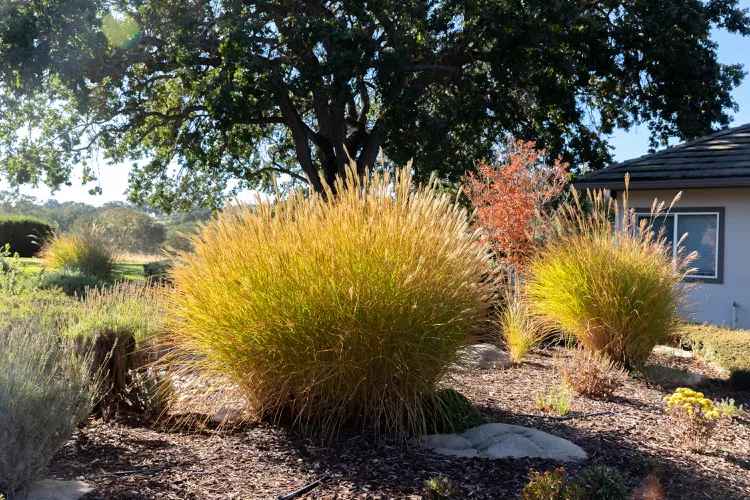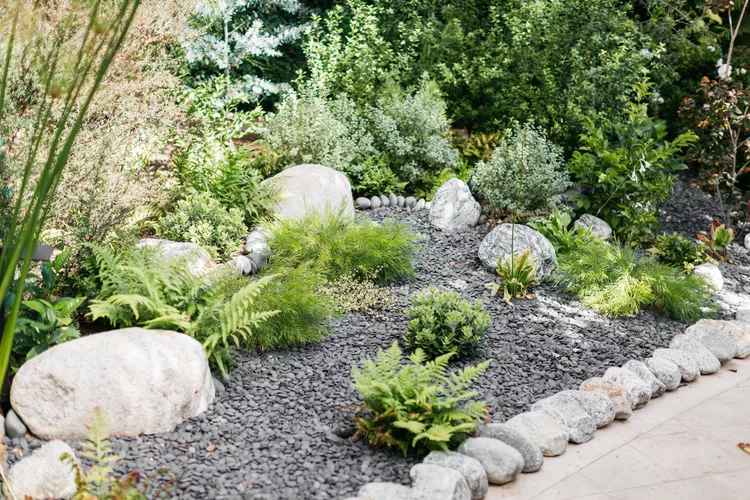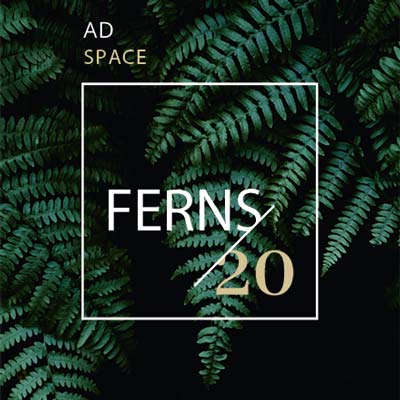You don’t have to build a fence or a wall in your yard to achieve privacy. Plants can be strategically placed in your yard to deter prying eyes. Although shrubs and trees are the most common plants used for privacy, other plants such as vines and trees can also be used.
Sometimes privacy shrubs can be sheared into neat hedges. They can also be grouped loosely along the border. Growing plants to achieve privacy has the advantage of attracting wildlife or changing seasonally.
These 20 plants and shrubs will help you to create privacy in your garden.
01
Hick’s Yew
Close-up of red berries on a yew bush.
The yew shrub is the perfect choice for privacy. The evergreen needled leaves will not allow you to lose privacy in winter.
As yews are hardy and tough plants, they can be easily clipped to create a neat fence. If you water yews during dry spells, and prune them and fertilize them every year, they will flourish as long as there is good drainage. The yew also produces beautiful red berries.
Hick’s Yew makes a good privacy hedge because of its height. It can be planted in loose borders because it has a column shape.
Name: Hicks’ yew
USDA Hardiness Zones 2 to 10
Color: green leaves with red berries
Light: From full sun to partial shade
Soil: Well-drained, loamy, moist
Mature size: 15 feet by 20 feet
02
Emerald Green Arborvitae
Arborvitae shrubs form a loose hedge.
Emerald Green Arborvitaes have a medium size for their genus. The arborvitaes will look great either as a formal border or as a hedge. Arborvitaes are primarily used to provide privacy in a yard. Their foliage is dense and green throughout the year.
Arborvitae generally does not tolerate drought. Keep the soil evenly moist all summer long.
Name: Emerald Green arborvitae (Thujaoccidentalis ‘Emerald Green’)
USDA Hardiness Zones 2 to 7
Color: Green, scale-like, evergreen leaves
Light: full sun to partial sunlight
Soil: Well-drained, moist
Mature size: 12 to 20 feet tall and 3 to 10 feet wide
03
Green Giant Arborvitae
Arborvitae hedge.
Arborvitae shrubs generally do not grow very fast, but Green Giant is an exception. It can grow up to 5 feet in a year. This arborvitae is tall and makes it an excellent choice for privacy. It is best to grow it as a loose, untrimmed border instead of a neatly shaved one.
Name: Green Giant Arborvitae (Thuja standishii x Thuja plicata)
USDA Hardiness Zones 2 to 7
Color: Green, scale-like, evergreen leaves
Light: full sun to partial sunlight
Soil: Well-drained, moist
Mature size: 40 to 60 feet high, 12 to 18 foot wide
04
Common Juniper
Close-up of blueberries on common juniper
Evergreen junipers have awl shaped leaves. The species plant (about 5 feet high by 13 feet wide) is a low spreading shrub. The cultivars are what homeowners care about. They can range from large, tree-like plants to small groundcovers.
For privacy, homeowners will choose a taller variety such as Hibernica (15 feet). The common juniper is a hardy plant that requires little maintenance. However, they do best in moist soil with good drainage and full sun.
Name: Common juniper (Juniperus communis)
USDA Hardiness Zones 2 to 7
Color: Green, awl-like, evergreen leaves
Light: Full Sun
Soil: Well-drained
Mature size: depends on cultivar
05
Pfitzer Chinese Juniper
Blue Pfitzer Juniper shrubs sheared into pom poms.
It is often sheared to make pom-poms. If you want it for privacy, let it grow naturally. It is less cold-hardy than common juniper, and susceptible to root rot. Make sure that the soil drains properly.
Name: Chinese juniper (Juniperus chinensis ‘Pfitzeriana’)
USDA Hardiness Zones 4 to 9
Color: Sage-green, awl-like, evergreen leaves
Light: Full Sun
Soil: Well-drained
Mature size: 5 to 10 feet high and 15 to 20 foot wide
06
Mountain Laurel
Privacy is achieved by adding a Laurel hedge to the yard.
Mountain laurel can be used to create privacy in the shade. The foliage of mountain laurel is tolerant to a little shade but needs more sunlight to reach its full potential.
In spring, fertilize it with a plant-food formulated specifically for acid-loving plants. Avoid root rot by not planting it too deep (the crown should not be buried).
Name: Mountain Laurel (Kalmia latifolia)
USDA Hardiness Zones 4 to 9
Color: White, rose, pink or green flowers.
Light: From full sun to partial shade
Soil: cool, rich, moist. well-drained. acidic
Mature size: 5 to 15 feet tall.
07
Privet
Privet hedge on front of the house.
Privet and privacy are almost synonyms. This broadleaf can be evergreen or deciduous depending on its type. Most often, it is planted in rows to create a formal fence.
Name: Privet (Ligustrum spp.)
USDA Hardiness Zones 3 to 8
Color: White flowers followed by black berries; glossy green leaves
Light: From full sun to partial shade
Soil: Well-drained
Mature size: 4 to 15 feet tall and 4 to 10 feet wide
08
Golden Privet
Golden privet shrub
Try the ‘Vicaryi” cultivar if the green of the regular privet is not your style. It has bright golden leaves but can be used the same as regular privet. It will create a stunning contrast when planted next to darker plants.
Name: Golden privet (Ligustrum ‘Vicaryi’)
USDA Hardiness Zones 5 to 8
Color: Golden leaves, white flowers followed by black berries
Light: From full sun to partial shade
Soil: Well-drained
Mature size: 6 to 12 feet tall and 7 to 10 feet wide
Continue to 9 below.
09
English Holly
English holly with berries.
Holly is an evergreen shrub that’s often associated with winter holidays. Its prickly foliage deters would-be intruders, as well as obscuring unwanted glances from passersby. It needs a pH that is acidic and a soil with good drainage.
Name: English holly
USDA Hardiness Zones 7 to 9
Color: Glossy green broadleaf with red berries
Light: From full sun to partial shade
Acidic, well-drained soil
Mature size: 3 to 50 feet high, 15 to 25 foot wide
10
Blue Prince and Blue Princess Holly
Blue Princess holly leaf close-up
Blue Princess, along with its pollinator Blue Prince, is another option for broadleaf evergreen shrubs to provide privacy. Sometimes they are planted as a hedge, but also look great grouped loosely along the border.
Name: Blue Prince/Princess Holly (Ilex meserveae “Blue Prince”/’Blue Princess”)
USDA Hardiness Zones 3b to 7a
Color: Dark green glossy with a bluish cast. Red berries
Light: From full sun to partial shade
Acidic, well-drained soil
Mature size: 15 feet tall and 8 to 10 feet wide
11
English Ivy
You can also use vines to add privacy to your garden. Vines are not very strong and require support like a fence or pergola. Homeowners often hide chain-link fences with vines (because they are unattractive). The vine serves two purposes: it adds privacy to the yard and enhances its appearance.
Woody vines are the best to grow for privacy. They will grow faster as they get a head-start on the vines which have to emerge from the ground each spring. They will also provide privacy all year round if they are evergreen.
English ivy, for example, is a vine that grows evergreen.
Name: English ivy
USDA Hardiness Zones 4 to 13
Color: Rich green leaves with lighter-colored veins
Light: partial shade to full shade
Fertile soil: moist and fertile
Mature size: N/A, climbs and spreads to the maximum extent possible
WARNING
English ivy can be invasive, especially in North America. Fortunately, some vines that are non-invasive are available, even though they are not evergreen.
12
American Wisteria
Chinese wisteria blossoming on pergola.
American wisteria, along with other deciduous vines, will only add privacy in the summer and fall. Wisteria’s racemes are worth growing just for the flowers. Woody vines can become heavy as they grow.
Name: Wisteria
USDA Hardiness Zones 5 to 9
Color: Purplish or blue flowers
Light: From full sun to partial shade
Soil: Well-drained
Mature size: 10 to 25 feet in length, 4 to 8 foot wide
13
Dutchman’s pipe
Dutchman’s pipe growing along a fence or wall.
Dutchman’s Pipe’s flowers are not as impressive as wisteria, hence the “pipe” name. The dense foliage of this deciduous vine makes it an excellent privacy plant. This woody vine will be infected by fungus if you water it from above.
Name: Dutchman’s pipe (Aristolochia macrophylla).
USDA Hardiness Zones 4 to 8
White flowers
Light: full sun to partial sunlight
Soil: Well-drained
Mature size: 15 to 30 feet tall and 15 to 20 feet wide
14
Climbing Hydrangea
Hydrangea climbing
Many plants are listed for partial shade but don’t really thrive there. They tolerate it, but don’t grow. Climbing hydrangeas are different. This woody vine performs well in shade and is a good choice for privacy.
Name: Climbing hydrangea
USDA Hardiness Zones 4a to 8a
Color: Medium green leaves with white flowers
Light: From full sun to partial shade
Soil: Well-drained
Mature size: 30 to 50 feet high, 5 to 6 foot wide
15
Arctic Kiwi Vine
Three-color male arctic Kiwi vine leaves.
Arctic Kiwi is a woody plant with variegated leaves in pink, green, and white. Colors are at their most vibrant in the spring and fade as summer progresses. This plant is a heavy feeder and needs lots of nitrogen. Each spring, add about 3 inches to its soil.
Name: Arctic Kiwi
USDA Hardiness Zones 3 to 9
Color: Variegated pink, white and green foliage
Light: full sun to partial sunlight
Soil: Loamy, well-drained
Mature size: up to 30 feet long
16
Copper beech hedge.
Even trees can be used as a screen to keep out unwanted eyes. The best trees for small and medium sized properties are those that remain short or get bushy after being pruned.
The best privacy screens are usually evergreens, which keep their foliage all year round, while deciduous trees lose their leaves during the fall. Copper beech is an exception. Copper beech is popular because it can be easily pruned to keep it compact.
Name: Copper beech
USDA Hardiness Zones 4 to 7
Color: Purple leaves become coppery in winter
Light: From full sun to partial shade
Soil: fertile and deep soil that is moist but drains well
Mature size: 50-60 feet high and 30 to 45 feet wide
17
Canadian Hemlock
Picture of a hemlock fence.
Hemlock is another tree that can be used for privacy screens. There are cultivars that can be used as hedges with minimal pruning. ‘Aurea Compacta,’ with its golden-colored leaves, reaches only 5 feet tall and has a spread that is about half as large.
Name: Canadian hemlock (Tsuga canadensis)
USDA Hardiness Zones 3 to 7
Color: Evergreen needles
Light: From full sun to partial shade
Soil: Well-drained, moist
Mature size: 70 feet tall, 25 to 35 foot wide
18
Eastern White Pine
Close-up of an eastern white pine branch
Eastern white pine is a third example of an evergreen tree that can be used as a privacy screen. It can be easily pruned into a shrub shape.
Name: Eastern White Pine (Pinus Storbus)
USDA Hardiness Zones 3 to 8
Color: Evergreen needles
Light: full sun to partial sunlight
Soil: Well-drained
Mature size: 50 to 80 feet high, 20 to 40 foot wide
19
Maiden Grass
Maiden grass with fall tassles
Maiden grass, for example, is a tall ornamental grass that can be used to create privacy. Some growers trim it back in the fall. However, those who use it as a privacy screen leave it dried all winter. The plant is a great winter accent.
Name: Maiden grass (Miscanthus sinensis)
USDA Hardiness Zones 5 to 9
Color: Coppery flower heads and green leaf blades in early autumn later turn into silvery-white plumes to add winter interest
Light: full sun to partial sunlight
Soil: Well-drained
Mature size: 4 to 12 feet tall and 4 to 6 feet wide
20
Black Bamboo
Closeup of black bamboo canes.
Running bamboos are black bamboos. It spreads rapidly via underground rhizomes. Bamboos can be invasive outside of their native ranges.
Its aggressiveness can either be a good thing or a bad thing, depending on what you want to achieve. This plant’s aggressive nature can work in your favor if you want to create a privacy screening. Noise barriers can also be made from black bamboo.
Name: Black bamboo
USDA Hardiness Zones 7 to 10
Black stalks
Light: From full sun to partial shade
Soil: Well-drained, moist, loamy
Mature size: 30 feet tall and 2 inches wide





